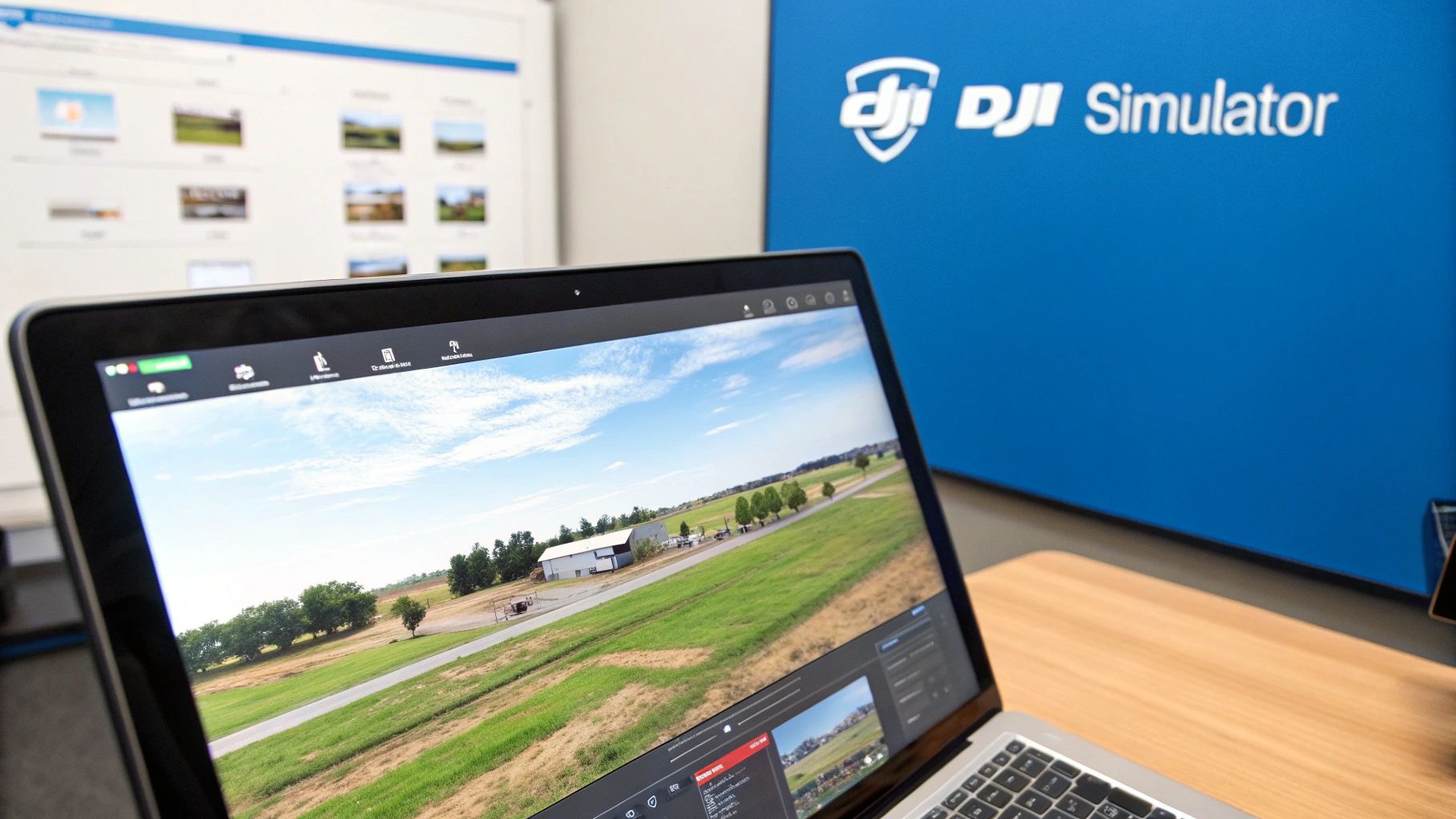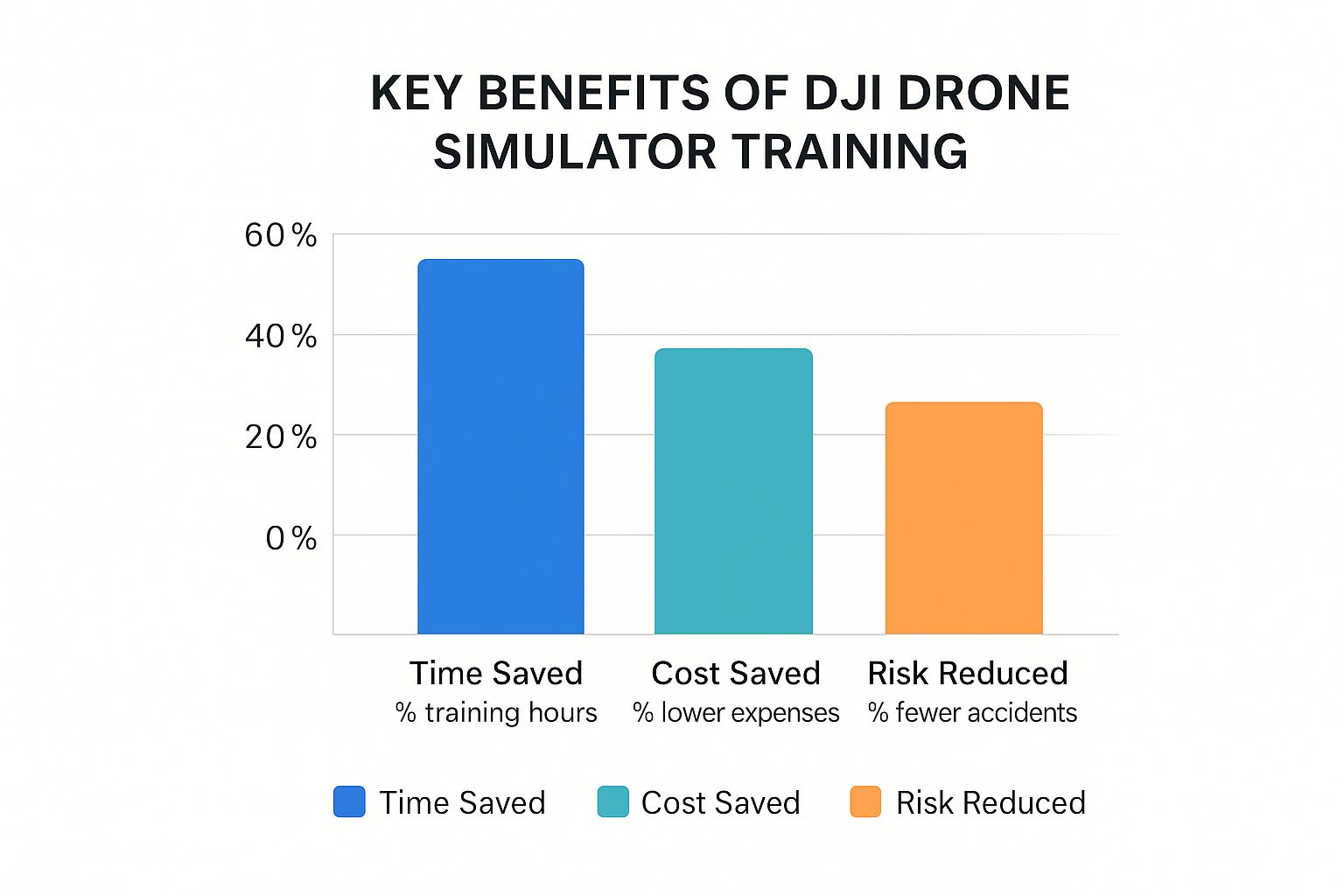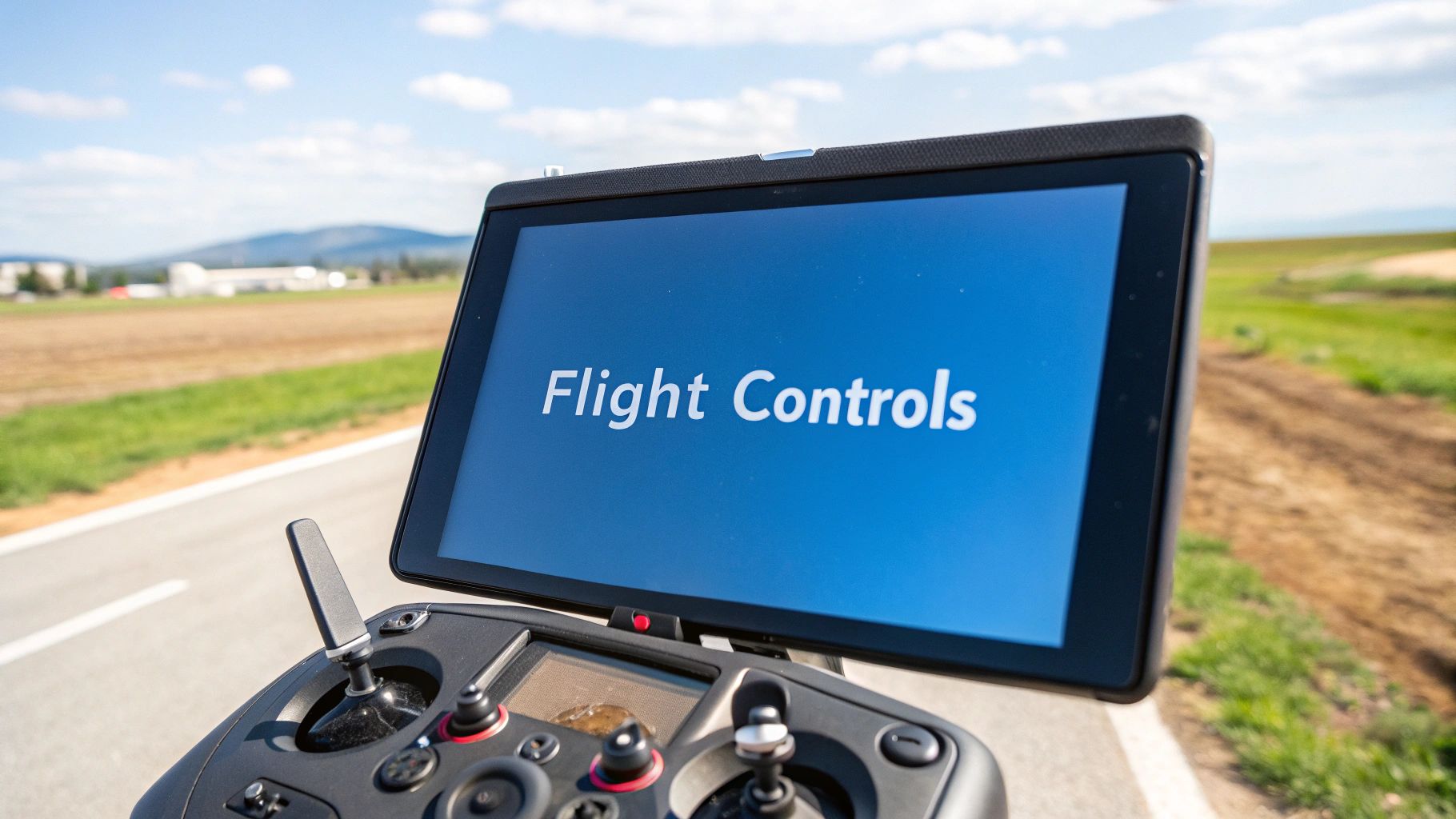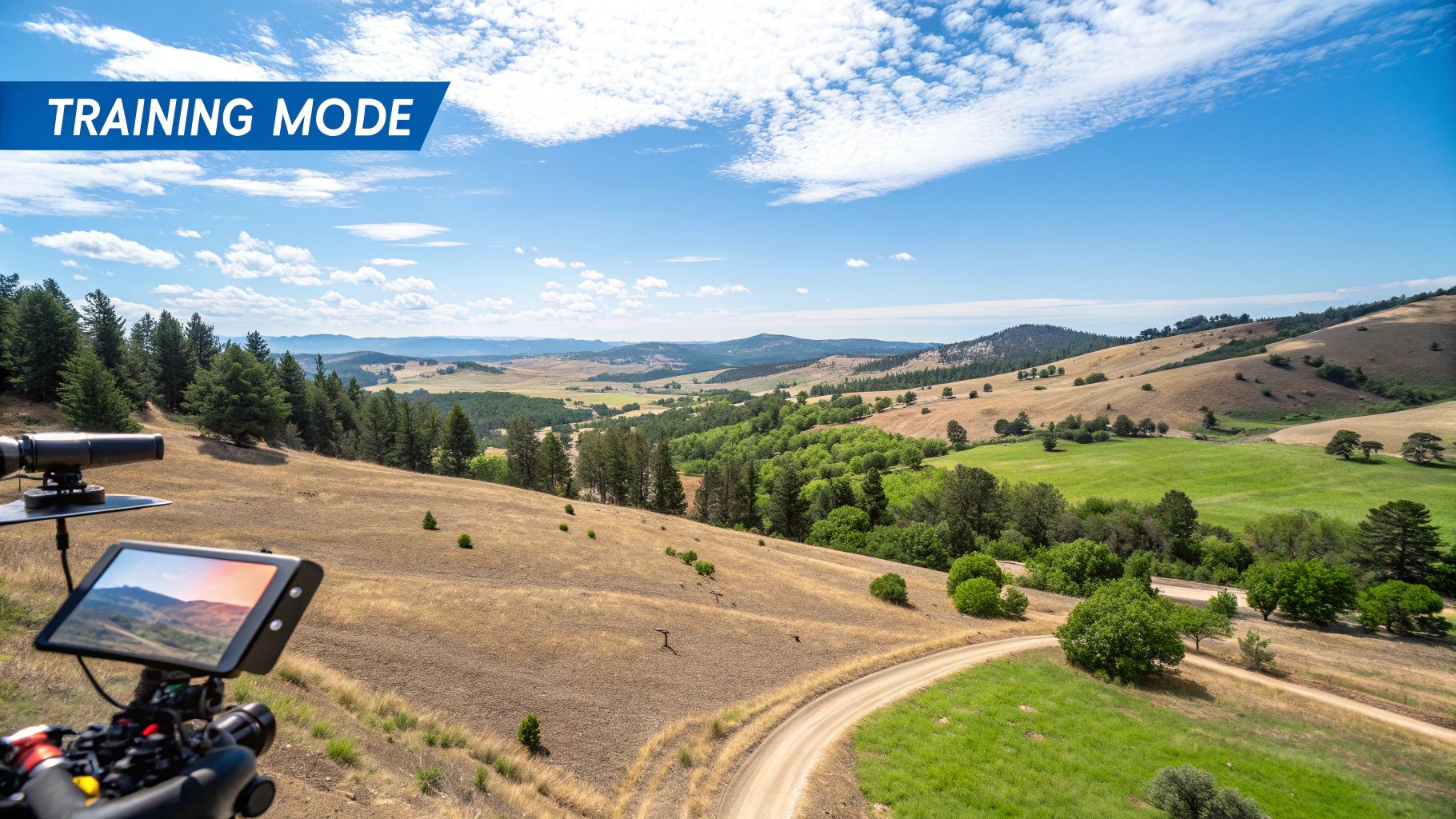Master Your Skills with DJI Drone Simulator | Practice Risks-Free
- James Baptiste

- May 7, 2025
- 10 min read
Why DJI Drone Simulator Is Your Essential First Step
Imagine unboxing your new DJI drone, picturing stunning aerial footage. But what if a sudden gust of wind or a simple miscalculation leads to a crash? A DJI drone simulator can prevent this. It's the crucial first step for new pilots, offering a risk-free space to practice.
Experienced pilots also recognize the value of simulated flight time. These virtual environments accurately recreate the flight characteristics of different DJI models, from the Mini series to the Inspire line. This helps develop muscle memory and reactions that transfer to real-world flying. Think of it as driver's ed for drones.
Understanding the Benefits of Simulated Flight
DJI drone simulators do more than just mimic controls. Their physics engines recreate realistic scenarios, including wind, obstacles, and battery life. You can practice flying in challenging environments like forests or coasts, preparing for the unexpected. You can also experiment with camera settings and flight modes without fear of crashing.
This realism builds confidence and competence. It helps you understand how your drone reacts to different inputs and environmental factors. When you finally fly your DJI drone, you'll have the skills and knowledge to do it safely and effectively. The drone simulator market is growing rapidly, reflecting these benefits. In 2022, the market was worth about USD 799 million and is predicted to reach USD 1,501 million by 2027, with a 13.4% CAGR. This highlights the growing importance of simulator training. Find more detailed statistics here
From Virtual Training to Real-World Confidence

Mastering the controls in a simulator builds a solid foundation for real-world flight. It lets you develop key skills like precise maneuvering, smooth camera movements, and efficient battery use. However, simulator training isn't a complete replacement for real-world experience. Factors like environmental awareness, weather, and the feel of the drone still require practice.
The key takeaway is that a DJI drone simulator is an invaluable tool for minimizing risk. It's a cost-effective way to gain experience, build confidence, and become a better pilot. This preparation protects your investment and increases your enjoyment. By starting with a simulator, you're well on your way to capturing amazing aerial shots.
Finding Your Perfect DJI Drone Simulator Match
Choosing the right DJI drone simulator is crucial for effective training. A poorly chosen simulator can waste valuable practice time. This section guides you through the available options, comparing official DJI simulators with trusted third-party alternatives. We'll explore their strengths and weaknesses, considering factors like realism, compatibility, and your specific goals. Whether you're mastering basic flight, perfecting cinematic shots, or practicing commercial operations, finding the right simulator is key.
Official DJI Simulators: Pros and Cons
DJI offers its own simulation platforms, each with unique features. DJI Flight Simulator is a comprehensive solution for professional training, offering highly realistic physics and a wide range of DJI drone models. However, it has a higher price tag and requires powerful hardware. For beginners, the mobile app DJI Virtual Flight offers a more accessible entry point, but with simplified physics and limited scenarios.
Third-Party Simulators: Expanding Your Options
Several third-party simulators offer DJI controller compatibility, letting you practice with your own hardware. These simulators often provide a broader range of environments and challenges. Some specialize in specific skills like FPV racing or cinematography. Keep in mind, their physics engines and drone-specific handling may not always match the accuracy of official DJI simulators.
Matching Simulators to Your Goals
Your training goals will determine the ideal simulator. For basic training, a mobile app like DJI Virtual Flight or a free third-party option might suffice. For mastering complex maneuvers and professional operations, investing in DJI Flight Simulator or a high-end third-party alternative is recommended. You might be interested in: our sitemap for other helpful articles.
Evaluating Realism and Effectiveness
The most valuable simulators offer realistic physics, environmental challenges, and drone-specific characteristics. Look for simulators that accurately model wind effects, obstacle interactions, and battery performance. This helps develop muscle memory and reactions that translate to real-world flying.
The Impact of Simulator Training: A Data-Driven Perspective

The infographic above illustrates the key advantages of simulator training: time saved, cost reductions, and risk mitigation. Simulator training can significantly reduce training time and lower expenses associated with crashes and repairs. Most importantly, it minimizes the risk of accidents. This underscores the importance of simulated practice before flying your DJI drone.
To further assist in your decision-making process, the following table compares some of the most popular DJI drone simulators:
Comparison of Popular DJI Drone Simulators: A detailed comparison highlighting key features, compatibility, pricing, and ideal user profiles.
Simulator Name | Compatible DJI Models | Key Features | Price | Best For | User Rating |
|---|---|---|---|---|---|
DJI Flight Simulator | Various | Realistic Physics, Comprehensive Training Modules | High | Professional Pilots, Enterprise Users | High |
DJI Virtual Flight | Select Models | Basic Flight Training, Mobile App | Low/Free | Beginners, Casual Users | Medium |
Other Third-Party Simulators | Varies depending on simulator | Specialized Scenarios (e.g., FPV Racing, Cinematography) | Varies | Hobbyists, Specific Skill Development | Varies |
This table provides a general overview; researching specific simulators is crucial for making an informed decision.
Choosing the Right Simulator: Your Key to Safe and Successful Flights
Finding the perfect DJI drone simulator is an investment in your skills and safety. Carefully consider your needs, budget, and training goals to select a simulator that prepares you for real-world flight. This foundational preparation builds confidence and helps you master aerial control. Choosing wisely avoids frustration and maximizes your potential as a drone pilot.
Setting Up Your DJI Drone Simulator For Success
The difference between a frustrating and a productive learning experience with a DJI drone simulator often comes down to the initial setup. This guide will walk you through creating an effective training environment, covering everything from selecting affordable hardware to ensuring your controller connects reliably. Let's get started.
Hardware and Software Requirements: A Solid Foundation
Before your virtual takeoff, make sure your computer meets the minimum system requirements of your chosen DJI drone simulator. The DJI Flight Simulator itself, for example, requires more processing power and graphics capabilities than simpler mobile apps. For a smooth, lag-free experience, consider a dedicated graphics card, sufficient RAM, and a fast processor. This helps prevent frustrating delays and ensures realistic visuals.
Controller Calibration and Connectivity: Mastering the Controls
Connecting and calibrating your DJI controller is crucial for a realistic simulation. Most simulators offer step-by-step pairing instructions. However, troubleshooting connectivity issues can sometimes be necessary. Be sure your controller’s firmware is up-to-date and you're using the correct cable and connection port. Proper calibration ensures accurate control inputs, mimicking the feel of a real DJI drone.
Creating an Optimal Training Space: Ergonomics and Immersion
Consider your physical setup. Professional training centers prioritize ergonomics, positioning monitors and controllers for comfort and effective learning. Create a dedicated space free from distractions, with a comfortable chair and appropriate desk height. This will help you maintain focus and prevent fatigue during longer practice sessions.

Customizing Your Virtual World: Tailoring the Environment
Many DJI drone simulators offer environmental customization. You can tailor your virtual training grounds to match real-world locations or create unique challenges. Adjust wind speed and direction, add obstacles, and even change the time of day. Practicing in conditions that mirror your intended flying locations significantly improves skill transfer from the simulator to real-world flying. The global UAV simulator market is projected to reach $5670.42 million by 2032, growing at a CAGR of 18.00% from its $659.4 million size in 2019. This growth reflects the increasing complexity of drone technology and the need for effective training. Explore this topic further.
Preparing for Takeoff: Checklist and Final Steps
Before your virtual flight, run through a final checklist:
Controller Calibration: Confirm your controller responds accurately to your inputs.
Software Updates: Verify your simulator and controller firmware are up-to-date.
Environment Selection: Choose the virtual environment best suited to your training goals.
Distraction-Free Zone: Minimize interruptions for focused practice.
By following these steps, you'll create a productive and enjoyable simulator experience, maximizing your learning and preparing you for successful real-world drone flights.
Building Real Skills Through DJI Simulator Exercises
Simply buzzing around in a DJI drone simulator won't magically transform you into a skilled pilot. A structured approach to your simulator practice is key to transferring those virtual flight hours into real-world competence. We've spoken with numerous drone instructors and professional pilots to understand how they use simulators effectively. Based on their insights, we've developed a training progression that will systematically build your skills.
From Basic Maneuvers to Cinematic Techniques
This training progression starts with the fundamentals. You'll begin by mastering hover control and basic directional movements. Once you feel comfortable with these core skills, you can move on to more precision-oriented maneuvers like figure-eights and orbits. Finally, you'll be ready to tackle the complex cinematography techniques used by professional aerial filmmakers, such as reveals, tracking shots, and cable cam simulations. Each exercise has specific objectives, helps you identify common mistakes, and provides benchmarks so you can track your improvement.
Mastering Emergency Procedures in a Safe Environment
One of the greatest benefits of a DJI drone simulator is the ability to safely practice emergency procedures. Think about it: when would you ever want to practice a return-to-home procedure in a real-world scenario where you've lost signal or are experiencing a low battery? The simulator lets you rehearse these critical scenarios without risking your actual drone. This builds confidence and prepares you to react effectively in a real emergency, ensuring safer flights.
A Structured Training Plan for Consistent Progress
To help you get started, we've put together a sample training progression, outlining key exercises from beginner to advanced levels. The table below details the skills you'll develop, the criteria for mastering each exercise, and an estimated practice time.
To provide a more structured approach to your training, the following table illustrates a progressive plan, outlining key exercises and their respective objectives:
DJI Drone Simulator Training Progression
Skill Level | Exercise Name | Key Skills Developed | Completion Criteria | Estimated Practice Time |
|---|---|---|---|---|
Beginner | Basic Hover and Movement | Stable hover, directional control | Maintain hover within a 1-meter radius for 60 seconds | 2-3 hours |
Intermediate | Precision Maneuvers | Figure-eights, orbits, precise turns | Complete 5 consecutive figure-eights within a designated area | 5-7 hours |
Advanced | Cinematic Techniques | Cable cam, tracking shots, reveals | Execute a smooth tracking shot following a moving object for 30 seconds | 10+ hours |
Emergency Procedures | Return-to-Home, Signal Loss, Low Battery | Safe responses to critical situations | Successfully execute each procedure 3 times consecutively | 3-4 hours |
This table offers a roadmap for your simulator training. Remember, consistent practice is key to building a strong foundation for real-world flying. For additional support and guidance, check out our event page sitemap for workshops and training opportunities.
Measuring Your Progress and Refining Your Skills
Regularly assess your performance in the simulator. Are your movements smooth? How's your precision? How quickly can you respond to different situations? The simulator is a safe space to push your limits, experiment with new techniques, and refine your skills before flying your DJI drone in the real world. By identifying areas for improvement and focusing your practice, you'll gain valuable experience and confidence for when it matters most.
Bridging Virtual Practice To Real DJI Drone Success
A DJI drone simulator isn't just a game; it's a powerful tool for honing real-world flight skills. This bridge between simulation and reality unlocks the potential of simulator training. But how effectively do virtual hours translate to confident, real-world flight?
Real-World Results: How Simulators Impact DJI Drone Pilots
Numerous case studies showcase the benefits of simulator training. Some commercial operators report a 78% reduction in crashes among trainees who started with a simulator. This highlights its effectiveness in building fundamental skills and safe habits. Professional filmmakers use simulators to pre-visualize complex shots, saving time and resources on set. For further reading on related topics, check out our page sitemap.
Seamless Transfer: Skills That Translate Perfectly
Several drone control aspects transfer seamlessly from simulation to reality. Orientation awareness, understanding the drone's position, improves significantly through simulator practice. Developing smooth control inputs and mastering procedures like return-to-home become second nature with consistent virtual training. This builds confidence and prepares pilots for real-world challenges.
Bridging The Gap: Addressing The Simulator-Reality Divide
While simulators offer immense value, some aspects of drone flight still require real-world practice. Environmental awareness, like judging wind, demands real-world experience. Similarly, battery management in real flight can differ from simulated environments. Adapting to real-light conditions and compensating for variables like sun glare is also crucial. For more insights into pilot training, see this article about UAS pilot training.
Leading Drone Schools: Best Practices For Simulator Integration
Leading drone schools understand the importance of bridging the virtual and real. They combine simulator training with practical flight sessions. This blended approach lets students build foundational skills virtually and then refine them through hands-on experience. This ensures pilots develop a comprehensive understanding of drone operation. The drone simulator market is influenced by regional dynamics, with North America being a key player. By 2028, the North American market is expected to reach a value of $1.6 Billion, with a CAGR of 12.9%. Learn more about the drone simulator market. This emphasizes the growing importance of simulator training.
Maximizing Your Simulator Investment: Bridging The Gap To Real-World Success
By understanding the strengths and limitations of simulator training, you can maximize your investment and achieve true mastery in DJI drone operation. Focus on transferable skills, practice essential procedures, and supplement virtual practice with real-world experience to gain the confidence and competence to fly successfully.

Pro-Level DJI Simulator Techniques You're Missing
Beyond basic flight control, a world of advanced DJI drone simulator techniques can dramatically improve your training. These pro strategies, used by experienced commercial operators and competitive pilots, can transform your virtual practice.
Unlocking Hidden Potential: Advanced Simulator Settings
Many DJI simulator users overlook key customization options that can significantly impact training. Explore the simulator's settings to modify wind turbulence, visibility, and obstacle complexity. Practicing in simulated strong winds, for instance, prepares you for challenging real-world conditions.
Similarly, adjusting visibility helps develop crucial spatial awareness in less-than-ideal situations. This customization allows you to create highly specific training scenarios tailored to your individual needs.
Flight Logging and Performance Analysis: Data-Driven Improvement
Most DJI simulators record detailed flight logs, capturing data like stick inputs, drone position, and battery life. Analyzing this data reveals subtle control habits that might need improvement. You might discover, for example, a tendency to overcorrect on yaw, leading to inefficient flight paths.
Identifying and addressing these subtle issues in the simulator translates to smoother, more precise real-world flying. This data-driven approach is a key element of professional drone training programs.
Collaborative Training and Mission Rehearsal: Teamwork in the Virtual World
Professional drone teams use simulators for collaborative training, rehearsing complex missions before real-world deployment. This lets team members practice coordinated maneuvers, communication protocols, and emergency procedures in a risk-free environment.
This is particularly valuable for commercial operations like inspection or search and rescue, where precise teamwork is essential. For further reading, consider exploring our blog category sitemap for insights on drone technology. When you're ready to enhance your real-world footage, check out this article on Top 10 AI For Video Production Tools For 2025.
Community Resources: Sharing Knowledge and Custom Environments
The DJI simulator community is a valuable resource. Many online forums and communities offer custom environments, training challenges, and advice from experienced pilots. Sharing your own custom environments and connecting with other pilots can greatly accelerate your skill development.
This collaborative environment offers unique opportunities to learn from others and push your abilities.
Elevate Your Skills: From Virtual Practice to Real-World Mastery
By mastering these advanced techniques, you'll go beyond basic simulator use and unlock the full potential of virtual training. This leads to greater confidence, improved skills, and safer real-world flights.
Ready to improve your drone skills? Visit JAB Drone for expert insights, product reviews, and the latest drone news.




Comments